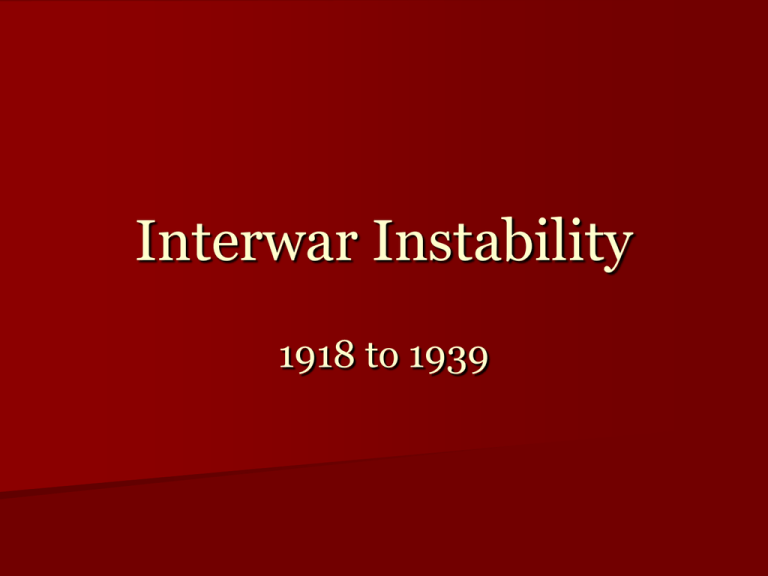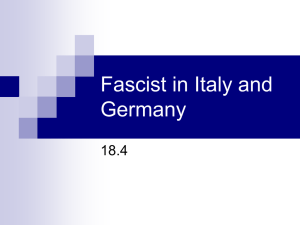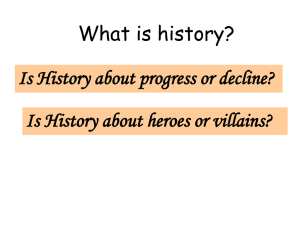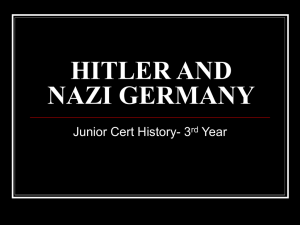Interwar Europe
advertisement

Interwar Instability 1918 to 1939 The Coming of War’s End Soviet Union withdraws from war: Treaty of BrestLitovsk (March 1918) § Give up claims to Poland, the Baltic States, Ukraine § Had to consolidate power in Civil War USA enters war (April 1917) § President Wilson offers ideological justifications for the war with his 14 Points § Huge influx of manpower for Allies on western front Second Battle of the Marne (Spring-early Summer 1918) breaks German spirit, but Ludendorff won’t declare ceasefire 9 November Kaiser abdicates; 11 November Armistice is declared Paris Peace Conference (1919) The “Big Four” •David Lloyd George of Britain •Vittorio Orlando of Italy •Georges Clemenseau of France •Woodrow Wilson of the United States •Public optimism based on Wilson’s 14 Points, among them: selfdetermination of nationalities; open diplomacy; general disarmament; and a League of Nations •Importance of “The National Question” & its complications •Specter of Communism: Soviet Union & Hungary (Bela Kun) Interwar Instability Outline Paris Peace Conference Realities of the Peace Lingering Uncertainties Weimar Germany & the Rise of Nazism Terms “Little Entente” Treaty of Rapallo Weimar Republic Hyperinflation The Dawes Plan Gustav Stresemann The Locarno Pact Kellogg-Briand Pact Adolf Hitler Emergency Decree Enabling Act Ernst Roehm Sturmabteilung (SA) Heinrich Himmler Schützstafel (SS) Josef Goebbels Realities of the Paris Peace Conference Decisions usually made by Big Four & their “experts” lead to resentment among the losers Conflicting concerns of the victors § France need security, England needs reparations, USA needs influence Features of the Peace Treaties (June 1919) § Harsh treatment of Germany: demilitarized; occupied; huge reparations; war guilt (Clause 231) § League of Nations set up (1920) with key states missing & without sharp teeth § Map of Europe redrawn, creating new countries at Austria’s & Russia’s expense Europe, post-1919 Realities of the Congress of Versailles Features of the Peace Treaties (June 1919) Map of Europe redrawn at Austria’s & Russia’s expense Harsh treatment of Germany: demilitarized; occupied; huge reparations; war guilt (Clause 231) League of Nations set up (1920) with key states missing & without sharp teeth Was this a “peace without victors”? In its original sense, no. Still, not even the “victors” found “peace” in the settlement. Civil War in the Soviet Union •“White” Russians & western allies try to stop Bolsheviks from consolidating power. •Soviets try to extend control by getting regional allies •By 1921, Soviets withstand threat and begin establishing their state. Unmet National Recognition: Ireland 1916-21 Easter Rising: Destruction in Dublin Home Rule movement, 1870s-1914: hopes raised and dashed The Irish Republican Brotherhood: underground alternative 1916 Easter Rising results in growing sympathy for republicans Irish question ignored at Versailles Guerrilla war, 1919-21, leads Lloyd George’s government to set up two “Home Rule” governments Lingering Discontents in Interwar Europe Civil war in the Soviet Union § “White” Russians & western allies try to stop Bolsheviks from consolidating power. Communist government uses Red Army (Trotsky) to fight enemies. § By 1921, Soviets withstand threat and begin establishing their state. Use of terror as an instrument of political and social control. Purges and camps. § Central economy implemented: Five Year Plans. Demands for national recognition unmet § Colonial possessions: Middle East; Africa; South Asia § Ethnic demands within Europe Economic uncertainties § Pre-war conditions changed § workers’ concerns up § Periods of severe downturns: 1919-20; 1926; 1929-34 Search for international stability § The “Little Entente” between Czechoslovakia, Yugoslavia, & Romania (1920) § Franco-Polish alliance to “contain” Germany (1921) The “Little Entente” France & new states seek allies “Little Entente” to keep an eye on Hungary and possibly Germany (1920) France makes separate alliance with Poland (1921) Growing suspicion among Germans and Soviets, who make their own agreement at Rapallo (1922) “The Little Entente” Mussolini and the Blackshirts Fascism in Italy Fasci di Combattimento or The Fascists (“Bands of Combat”) § Tended to be veterans who opposed Versailles settlement § Organized into armed bands; wore distinctive black shirts § Tended to be anti-union, violently breaking up meetings Led by Benito Mussolini: opportunist, self-promoter, nationalist Gained support as centrist parties unable to halt economic downturn: 1919-21 The March on Rome, October 1922 Mussolini & 50,000 supporters march on Rome: King Victor Emmanuel III didn’t stop them & then asks Mussolini to serve as Prime Minister Most thought he’d fail Nov. 1922: King grants him dictatorial power for a year Fascists secure control through intimidation, laws, propaganda, military efforts, economic corporatism & emphasis on dynamism. Factors for Mussolini’s Rise to Power Feelings of betrayal after the 1919 peace settlement. Italians felt they had been deprived of territory they had been promised to them by the other Allies. Italian government experiencing parliamentary chaos and had no clear political program. Fascism seemed to promise a way out of these economic and political troubles Italy was facing in the post-World War I era. Played on middle and upper classes' fears about inflation and concerns about their property rights. Components of Fascism The State is paramount § “Fascism is for liberty… the liberty of the State and of the individual within the State.” § “The keystone of Fascist doctrine is the conception of the State, or its essence, of its tasks, of its ends. For Fascism the State is an absolute before which individuals and groups are relative.” § “The Fascist State has a consciousness of its own, a will of its own, on this account is called and ethical state.” Corporatism Nationalism War as the natural state of society Promotes foreign expansion: Ethiopia, Albania Fascist Control Secured Through 5 Efforts The Lateran Accord, 1929: Indemnity to Pope; recognized authority of pope in Rome; recognized Catholicism as state religion War as “natural” condition: colonial campaigns in Lybiya and Ethiopia Organized Economy to achieve self-sufficiency and to promote the state: Corporatism – vertical orientation with state, owners & workers together Propaganda of DYNAMISM Pius XI with Mussolini, 1932 Mussolini a Symbol of Italian Dynamism Growing Relationship between Italy and Germany Hitler in Rome, 8 May 1938 The Soviet Union: From Lenin to Stalin Limits to control, even after Civil War § 600,000 Bolsheviks out of 160 million population § Use of army & secret police (the Cheka, later NKVD, much later KGB) New Economic Policy (1921) § Allowed for some private ownership in small shops § Kulaks: peasants farming for profit § Results: more stable food supply & industrial capacity back to pre-war level by 1927 Lenin dies (1924), sets up leadership struggle § Trotsky vs. Stalin Stalin vs. Trotsky Trotsky: middle-class, favored rapid industrialization & internationalizing revolution Stalin: peasant, “national” revolution, continue NEP Stalin used position as General Secretary to get support 1927: Trotsky removed from offices & exiled 1929: Trotsky kicked out of USSR; killed in 1940 Stalin’s Regime: Totalitarian Communism Economic Shift: from NEP to rapid industrialization § Gosplan and 5-year plans § Huge Growth: 400% (1928-1940) § Conditions horrible Kulaks Eliminated in favor of Collective Farms § 400,000 families “removed” § Collectives = 1,000 acres; equipment from state; controlled food supply; poor living conditions § Results: Ownership shift to State: 2% (1928) to 90% (1938) Production up 40%, but food shortages remained Purges: control through terror, “kangaroo courts” § Millions exiled, executed § New men attached to Stalin come to power Interwar Instabilities (cont.) Outline IV. Weimar Germany & the Rise of Nazism V. The Nazi Vision VI. The Final Solution VII. Fascism in Italy Terms Mein Kampf Lebensraum Nuremberg Laws Kristallnacht Einsatzgruppen Wannsee Conference The Fascists Mussolini March on Rome The Lateran Accord Corporatism Seeking Stability in Weimar Germany Weimar’s built-in instability § Constitution: President and Reichstag with Proportional Representation & Article 48 § Attempted revolutions from Left and Right Anger at Versailles Treaty Clauses: reparations bill and guilt French under Poincare invade the Ruhr Valley, 1923-25 § Germans hold general strike § Hyperinflation Stability comes via the Dawes Plan, Gustav Stresemann, the Locarno Pact (1925), & Kellogg-Briand Pact (1929) The Mask Falls The Demise of Weimar “Cabaret to Beauty” by Otto Dix (1922) Berlin a culturally decadent, vibrant, lonely city American money and culture flowing in until 1929 Impact of Great Depression § Party coalitions unable to deal with crisis § Unemployment grows from 2.25m (1930) to 6m (1932) President, Field Marshall Paul von Hindenburg started to rule by decree and to rely on a small circle of advisors In early 1933, Hindenburg calls on Adolf Hitler to become new Chancellor The Nazis & Adolf Hitler (1889-1945) National Socialist German Workers’ Party (f. 1919): sought repudiation of Versailles; unification of Austria and Germany; exclusion of Jews from German citizenship; land reforms and encouragement of small businesses § Party had paramilitary component: the S.A. under Ernst Roehm § Beerhall Putsch (1923) Hitler had joined in 1920 & rose to leadership What was the Nazi Vision? Restructure Europe to benefit the racial hierarchy § Mein Kampf places Aryans at top: “He furnishes the gigantic building-stones and also the plans for all human progress.” § Unite “ethnic” Germans (Volksdeutsch) in a “Greater Germany” § Lebensraum or “Living Space”: Must move eastward and push out those already living there. What was the Nazi Vision? Restructure Europe to benefit the RACIAL HIERARCHY § Mein Kampf places Aryans at top: “He furnishes the gigantic building-stones and also the plans for all human progress.” § Unite “ethnic” Germans in a “Greater Germany” § Lebensraum or “Living Space” Jewish Girl Photographed at the Institute for Racial Research (1936) Nazi Identification Table: “German Race Heads” What Was the Nazi Vision? Youth culture & fitness programs central Motherhood had special emphasis. Mein Kampf: “Marriage also cannot be an end in itself, but has to serve the one greater aim, the propagation and preservation of the species and the race.” What was the Nazi Vision? Restructure Europe to benefit the racially superior peoples Mein Kampf places Aryans at top. Übermenschen. Mixed races (like the USA) incapable of world leadership. Unite “ethnic” Germans (Volksdeutsch) in a “Greater Germany” Lebensraum or “Living Space” Central theme of racial hierarchy & exclusivity in Mein Kampf (1925) & Goebbels’s propaganda: “My neighbor is one who is tied to me by his blood. If I love him, then I must hate his enemies. He who thinks German must despise the Jews.” What was the Nazi Vision? Nazi Racial Ideas Aryans/Germans “Semi-Aryans” (Scandinavians) Himmler spoke of the war in the east as a “war of extermination.” Anglo-Saxons & other Europeans “Untermenschen” Vermin: Jews, Gypsies, Gays Nazi Seizure of Power (1933) Nazis play off difficulties of other parties with their own certainties: racism, expansionism, & anti-bolshevism Party grows with young, lower-middle-classes & small farmers: 37.3% (1932) Hindenburg’s invitation touches off quick series of events § Emergency Decree (Feb. 1933): suspend civil liberties; round up communists § March Election & the Enabling Act: Rule by Decree § July 14, 1933: Nazi Party declared only legal party in the state § June 30-July 2, Night of the Long Knives: SA out & SS gains power Five Phases of Anti-Jewish Action Definition: 1933-35 Expropriation: 1935-38 Concentration: 1933-42 Uncoordinated killing: 1939-42 Annihilation: 1942-45 About 600,000 Jews in Germany Nuremberg Laws (1935), which defined who was and wasn’t Jewish Limited contacts between “Germans” & “Jews” 5 October 1938 – All Jewish passports must be stamped with the letter “J.” November 1939 – Jews in Poland had to wear a white badge with a Star of David on their right arm. 1 September 1941 – Jews in Germany & occupied Poland were ordered to wear the Yellow Star “Know the True Enemy! Whenever You See This Symbol…Jew” Ober Ramstadt Fire Expropriation Sites of Major Kristallnacht Incidents Excluded from professions & gov’t jobs Set higher tax rates for Jews “Aryanized” Jewish businesses & property: Sept. 1937 Emigration: @300,000 leave Culmination: Kristallnacht, 9-10 Nov. 1938 § 267 Synagogues burned § 7,500 Stores & offices destroyed § 91 Dead § 30,000 arrested and deported to concentration camps § All Jewish businesses closed Interwar Instabilities (cont.) Outline IV. Weimar Germany & the Rise of Nazism V. The Nazi Vision VI. The Final Solution VII. Fascism in Italy VIII. Communism in the USSR Terms Einsatzgruppen Wannsee Conference The Fascists Mussolini March on Rome The Lateran Accord Corporatism Cheka New Economic Policy Kulaks Josef Stalin Concentration The Warsaw Ghetto Discomfort in smaller towns Moved to cities voluntarily: by 1939, 2/3 of German Jews lived in ten cities April 1939, German Jews forced to “relocate” into ghettoes away from general population Sept. 1939, Polish Jews forced into ghettoes Sept. 1941 German Jews begin “relocating” eastward Ghetto conditions intentionally horrid § Local councils & police § Limited & uncertain food supply § Hard labor & physical abuse A Dutch Family Gets Deported Uncoordinated Killing Executions and mass grave in Germanoccupied Soviet Union Einsatzgruppen are mobile killing squads of the SS, which move eastward alongside of advancing troops Rounded up political opponents and then Jews and then took them out to secluded sites for mass killings 1.5 m killed Annihilation Wannsee Conference, 20 January 1942 Final Solution built off existing ideas Dozens of camps, including 20 large ones & 6 specially designed for mass extermination § § § § § § Chelmno Belzec Sorbibor Treblinka Lublin Auschwitz-Birkenau Use of Zyklon B (hydrogen cyoniade), could kill up to 2,000 per day About 6 million Jews and others killed Mass Killings: Wannsee Conference (20 January 1942) & The Final Solution “Work Makes You Free” Arrival & Selection Faces from Auschwitz-Birkenau The Impact of the Final Solution on the Jews of Europe Ger/Aus Poland Baltics Ukraine Romania Slovakia Hungary 1939 240 3,300 253 1,500 600 90 630 1945 30 300 25 600 300 15 180 Number of Jews (in 1000s) Living in Select Countries Keys to Nazi Control The Autobahn, 1937 Rally at Nuremberg, 1934 Police & SS Presence Heinrich Himmler Economic Recovery through state-sponsored projects & military spending Public Relations chief Josef Goebbels Censorship, rallies, & radios








